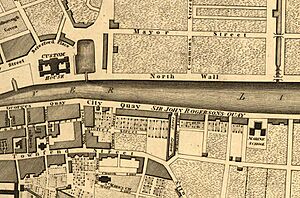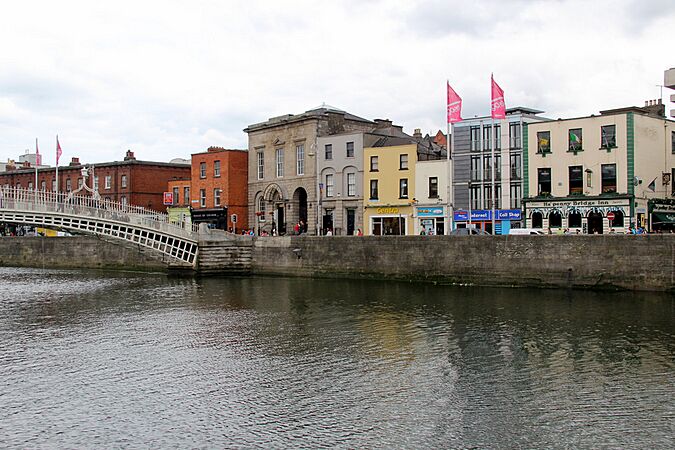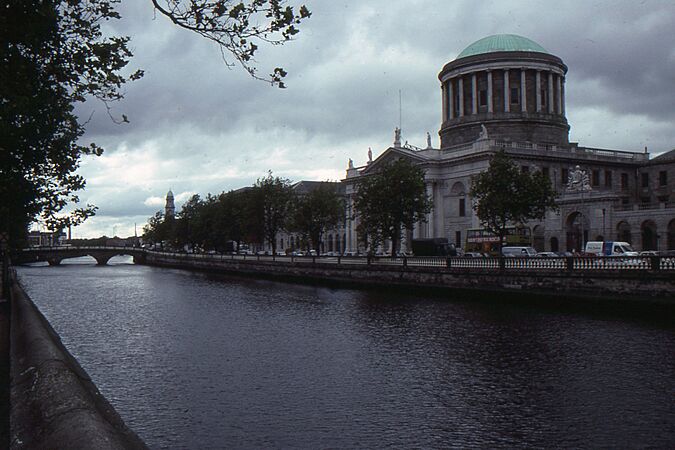Dublin quays facts for kids
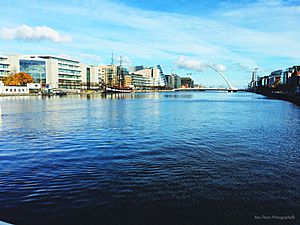
The Dublin quays (which means Céanna Bhaile Átha Cliath in Irish) are two main roads and riverbanks that run along the north and south sides of the River Liffey in Dublin, Ireland. These long streets have many different names, but most of them include the word "quay." The quays have been a very important part of Dublin's history for a long time.
A big part of the road on the south side and about half of the road on the north side are part of the R148 road. The other half of the north road is part of the R801 road.
Contents
Exploring the Quays
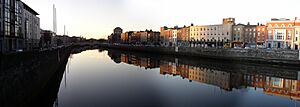
Both roads stretch for about 4.3 kilometers (2.7 miles) from Sean Heuston Bridge in the west. The north road ends at East-Link Bridge, while the south road turns south at the Grand Canal. There are seventeen bridges that cross the river along the quays. Three of these bridges are only for people walking, one is for trains, and two are for Luas trams. The rest are used by both cars and people.
The names of the north road, from west to east, are: Wolfe Tone Quay, Sarsfield Quay, Ellis Quay, Arran Quay, Inns Quay, Ormond Quay Upper, Ormond Quay Lower, Bachelors Walk, Eden Quay, Custom House Quay, and North Wall Quay.
The names of the south road, from west to east, are: Victoria Quay, Usher's Island, Usher's Quay, Merchant's Quay, Wood Quay, Essex Quay, Wellington Quay, Crampton Quay, Aston Quay, Burgh Quay, George's Quay, City Quay, Sir John Rogerson's Quay, and Britain Quay.
Most of the roads in the city center are one-way. The north road goes east, and the south road goes west.
A Look Back in Time
The Vikings were some of the first people to settle in Dublin. Many Viking items have been found at what is now Wood Quay. The quays themselves were first built around the early 1200s, during the time of King John. He gave permission for people to build along the River Liffey. The quays became the main center for Ireland's shipping trade. However, by the 1800s, the river here became too shallow for the bigger, more modern ships.
On March 11, 1597, a large gunpowder explosion happened on the quays. This explosion destroyed about forty houses and badly damaged many others. It sadly killed 126 people and injured many more.
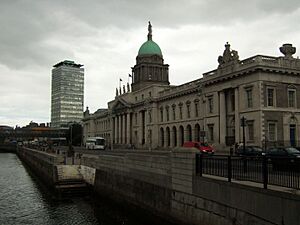
The Custom House, a famous building in Dublin located on Custom House Quay, was finished in 1791. The quay gets its name from this building. Later, the Four Courts building on Inns Quay was completed in 1802. Today, it is home to Ireland's highest courts, the Supreme Court of Ireland and the High Court. Both of these important buildings were designed by a well-known architect named James Gandon.
Burgh Quay is named after Elizabeth Burgh. Her son was John Foster, who was the last speaker of the Irish House of Commons. Burgh Quay was once home to the Tivoli Theatre. The Corn Exchange Building, designed by George Halpin in 1815, still has its granite front on Burgh Quay today. Ships used to travel as far upstream as Burgh Quay until 1879, when Butt Bridge was built. Some buildings on Burgh Quay still show parts of their original shop fronts.
The 1900s brought many changes to the quays. In 1845, McBirney, Collis & Company opened a store on Aston Quay. It stayed there as a department store called McBirney's until 1984. The building later became a Virgin Megastore in 1986, and now it's a SuperValu supermarket. A big discussion happened at Wood Quay in the late 1970s. The Dublin Corporation wanted to build there, but many ancient Viking items were found. This led to a very public effort to stop the building work, but it was not successful. Other quays also lost old buildings in the 1980s, like Arran Quay, where five Georgian houses were illegally knocked down in 1989.
In the early 2000s, the Liffey Boardwalk was built. This is a series of walkways along the quays, which was first announced in 1998 and opened in phases starting in 2000.
In 2006, some local politicians suggested changing the names of certain quays that were named after UK kings or queens. For example, MEP Gay Mitchell proposed renaming George's Quay or Victoria Quay to Joyce Quay or Behan Quay, after the famous Irish writers James Joyce and Brendan Behan.
Dublin Quays in Books and Art
A Picturesque and Descriptive View of the City of Dublin is a collection of 25 pictures of famous Dublin buildings and views. It was created in 1791 by the artist James Malton and includes many scenes along the quays.
Many artists have found inspiration from the quays. In 1898, writer Frances A. Gerard said that the Dublin quays made the city look "picturesque" and "foreign," like the quays in Paris. The Irish novelist James Joyce set many of his stories on the Dublin quays, including "Eveline" (1904) and "An Encounter" (1914). A writer who studied Joyce, Michael H. Begnal, said that Joyce connected the Liffey Quays with the idea of wanting to escape.
The artist Jack Butler Yeats painted a picture called Dublin Quays in 1916.
The 1987 film The Dead, based on a story by James Joyce, was filmed by John Huston at Usher's Island. In Joyce's story, "The Dead", two sisters, Kate and Julia Morkan, hold their yearly dance at their "dark gaunt house on Usher's Island." 'Ushers Island' was also the name of a horse that raced in the 1994 Grand National. In 2015, the folk musician Andy Irvine started a band called 'Usher's Island', named after the Dublin quay. The band includes musicians like Dónal Lunny, Paddy Glackin, and Michael McGoldrick.
Bachelors Walk was a comedy-drama TV show that aired in Ireland in March 2001. It followed the lives of three single men who lived on the quay called Bachelors Walk.
The famous writer Rudyard Kipling started his poem "Belts" with these lines:
- "There was a row in Silver Street, that's near to Dublin Quay / Between an Irish regiment an' English cavalree."
Famous Places Along the Dublin Quays
- 3Arena, also known as the Point Depot and the O2 (North Wall Quay)
- Central Bank of Ireland (North Wall Quay)
- Church of the Immaculate Conception, also called "Adam and Eve's" (Merchant's Quay)
- CHQ Building (Custom House Quay)
- Clarence Hotel (Wellington Quay)
- Collins Barracks (next to Wolfe Tone Quay, separated by Croppies' Acre Memorial Park)
- Convention Centre Dublin (North Wall Quay)
- Corn Exchange (Burgh Quay)
- The Old Custom House (Wellington Quay) (no longer standing, removed around 1814)
- The Custom House (Custom House Quay)
- Dublin City Council Civic Offices (Wood Quay)
- Dublin Port (east of the quays, towards Dublin Bay)
- EPIC The Irish Emigration Museum (Custom House Quay)
- Four Courts (Inns Quay)
- George's Dock (Custom House Quay)
- Guinness Brewery (Victoria Quay)
- Heuston railway station (close to Victoria Quay)
- International Financial Services Centre (Custom House Quay and North Wall Quay)
- The Italian Quarter (Ormond Quay Lower)
- Liberty Hall (Eden Quay)
- Merchants' Hall (Wellington Quay)
- Poolbeg Chimneys (east of the quays, towards Dublin Bay)
- Poolbeg Lighthouse (east of the quays, towards Dublin Bay)
- Royal Hibernian Marine School (Sir John Rogerson's Quay) (no longer standing, removed in 1979)
- Smock Alley Theatre (Essex Quay)
- Sunlight Chambers (Essex Quay)
- Temple Bar (Essex Quay, Wellington Quay, Crampton Quay and Aston Quay)
Images for kids



